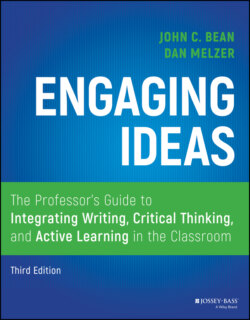Читать книгу Engaging Ideas - John C. Bean - Страница 76
The Value of Writing in Different Genres Seems to Be Supported by Brain Research
ОглавлениеBrain research makes the case that different kinds of writing tasks stimulate different parts of the brain. Kellogg (2008) explains that the frontal lobes of the brain, which seldom reach full maturity until age twenty‐three to thirty, are needed for complex writing tasks that require writers first to wrestle with advanced, domain‐specific knowledge and then to read their emerging texts from the audience's perspective. The strain on working memory can be reduced, Kellogg argues, by previous scaffolding exercises that encourage students to take notes, generate ideas during prewriting, make an outline, or learn the structural features of different genres. These different kinds of tasks apparently activate different parts of the brain.
Another study, by biologist James Zull (2002), shows that all new learning must be linked to preexisting neural networks already in the learner's brain. Teachers can't simply transfer a concept from their own brains into students' brains because a teacher's neural networks are the products of his or her own life history and don't exist within the learner's brain. Consequently, the learner must build the new concepts on neural networks already present. Informal writing assignments aimed at helping students probe memory, connect new concepts to old networks, dismantle blocking assumptions, and understand the significance of the new concept are particularly valuable.
Zull links his analysis of brain research studies to David Kolb's (1985) research on cognitive styles. Kolb plots an individual's cognitive style along four axes: concrete experience (feeling), reflective observation (watching), abstract conceptualization (thinking), and active experimentation (doing). Kolb recommends that for each learning unit in a course the instructor cycle through activities that focus on each of these learning styles, thus helping learners find at least one approach that most appeals to them while giving all students practice at thinking in less natural ways. Zull draws on brain imaging studies to argue that each of Kolb's quadrants corresponds with different regions of the brain, so that the kind of thinking or writing task associated with each quadrant particularly fires neurons in that region. Each phase of the cycle suggests a different kind of writing assignment, as shown in exhibit 3.2.
In sum, Zull's study suggests that different genres engage different parts of the brain and that teachers can deepen student learning by mixing personal writing (expressive, exploratory, reflective pieces) with academic and professional writing (mainstream academic papers, proposals, and persuasive pieces).
